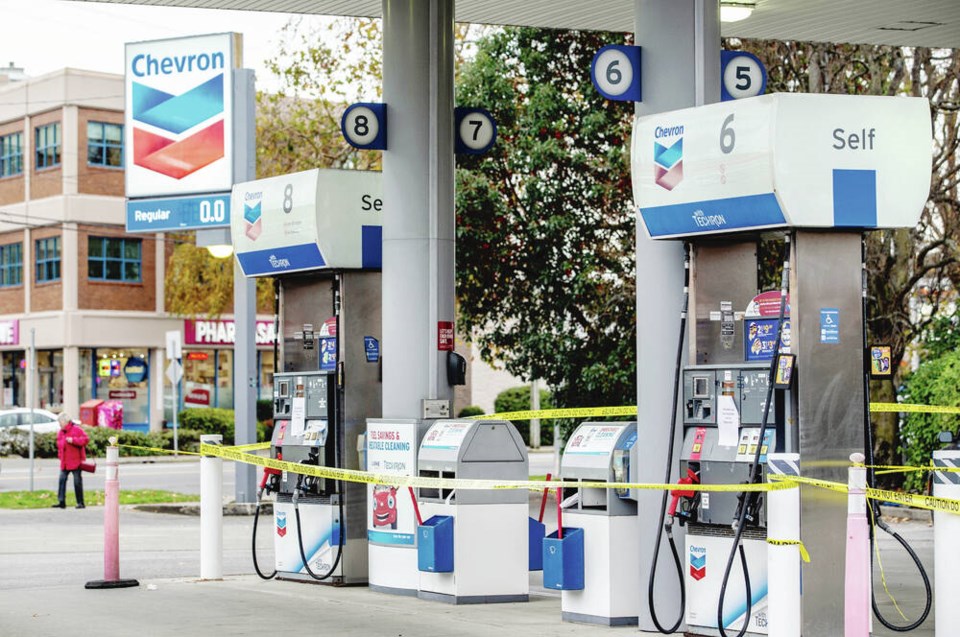There was a moderate shockwave in B.C. when the government announced fuel rationing measures on Nov. 17. The wipeout of every major road and rail transport line into the province along with the closure of the Trans-Mountain pipeline made the gasoline supply to thirsty B.C. vehicles suddenly precarious. But a week after the panic buyers swarmed in to top up, things seemed to have calmed down and so far it seems like most are buying into the government measures.
This is hardly the first time citizens have been up against fuel rationing in this province and based on historical records, drivers in 2021 are getting off lightly.
During our darkest hours of the Second World War, Canada started with a voluntary gasoline quota system on dealers. But less than a year after war was declared, the local pushback against gasoline rationing was full throated, this despite country after country in Europe falling under Nazi domination.
The May 2, 1940 Victoria Daily Colonist reported: “City Council Urges Immediate Steps to Provide Motor Fuel”.
Victoria mayor Andrew McGavin urged a meeting of local mayors and reeves to endorse a resolution for the provincial government and the oil companies to turn the taps back on for the civilian population. “Many persons are out of work and others are unable to carry on because of the inability to secure gasoline, …and municipalities are losing money”, said Gavin.
Then reminding us that some things never change in local governance, it took city solicitor, Forest L. Shaw, to inform the local elected wartime elders that the issue was beyond their purview. The system of fuel rationing, said Shaw, was an issue regulated by the federal government under the War Measures Act.
The oil industry was quick to throw in its two cents as well. On the same page as the city council article is a large ad from the Petroleum Industry of B.C. proclaiming to all that: “Government Monopoly Does Not Lower Prices — It Raises Them”. It also informed readers that in the past 18 years the government had the audacity to raise taxes on gasoline from nothing to a whopping seven cents.
Posturing and bickering like this arose throughout the country. By spring 1942 it was obvious that simply extolling the need for everyone to pitch in for victory and the voluntary quota system on dealers wasn’t working. The feds flexed their muscles under the War Measures Act and stopped fooling around.
Drivers were limited to 120 gallons of gas — per year. That’s because a Lancaster bomber needed up to 2154 gallons to launch a raid on Germany and return home. A Sherman tank couldn’t even go one mile on a gallon of gas. An armoured division at full tilt consumed 18,000 gallons an hour.
Making things worse, between 1939 and 1943, before the tide turned against them, German U-boats had sunk over 2000 ships in the north Atlantic, many of them carrying vital fuel supplies. In the south Pacific the Japanese had conquered Malaya and its vast rubber plantations. Gasoline and car tires became beyond precious.
Rationing cards were the order of the day and special exemptions, scrutinized by officials and sundry bureaucrats, were rarely granted. Government propaganda efforts strove to make the single car driver a pariah. Posters proclaimed: “When you ride alone — You ride with Hitler. Join a car sharing club today!”
Dunlop Tire posted an ad with a man soundly asleep in his bed, revolver in hand, a car tire tucked in beside him.
But the messages began to stick. Ridesharing, walking and hitchhiking became the norm. Many simply gave up driving for the duration.
It worked. By 1944 Canadians had saved an incredible 568,000,000 gallons of petroleum products, bearing in mind our population then was only about 12 million. We won the war.
Although it might not seem like it at the moment, the North American supply chain is now much more resilient than it was during the war. That, plus the rapid advancement of technology will probably save us from the draconian measures of wartime rationing. That’s a good thing because I wonder if today we’d be up to the challenges Canada saw from 1939 to 1945.
Glove Box: Why do some gas retailers like Chevron have an honour system for filling gas tanks to the 30 litre limit while others like Shell programmed their pumps for an automatic shutoff? A ministerial order is an order right?
Understandably, it’s all hands on deck for government during this flood crisis. But I hope they have sufficient people with lab coats and clipboards to study the effect of the Emergency Program Act ministerial order M454 on driver behaviour and fuel consumption patterns. Going forward we really need to know what worked and what did not.


